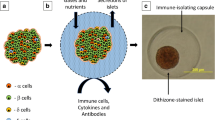Abstract
The primary objective of this work is to evaluate the potential of silica gel encapsulated pancreatic islets of Langerhans, or islet tissue, as a means by which insulin secretory capacity might be restored to individuals with insulin dependent, type 1, diabetes mellitus. The encapsulation material under investigation is comprised of sol-gel derived silica ceramic that hardens under conditions of pH, salinity, and temperature that are not harmful to living cells and organisms. Preliminary efficacy has been demonstrated by measurement of insulin secretory response of silica gel encapsulated pancreatic isletsin vitro and blood sugar levels of nonobese diabetic micein vivo.
Similar content being viewed by others
References
G. Hetenyi, The day after: How insulin was received by the medical profession. Perspectives in Biology and Medicine38(3), 396–405 (1995).
W.F. Ballinger and P.E. Lacy, Transplantation of intact pancreatic islets in rats. Surgery72, 175–186 (1972).
C.M. Peterson, L. Jovanovic-Peterson, and B. Formby (Eds.),Fetal Islet Transplantation: Implications for Diabetes (Springer-Verlag, New York, 1988).
P.M. Galletti, P. Aebischer, and M.J. Lysaght, The dawn of biotechnology in artificial organs. ASAIO Journal41(1), 49–57 (1995).
P.E. Lacy, Treating diabetes with transplanted cells. Scientific American, 50–58 (July, 1995).
J.A. Hubbell, Biomaterials in tissue engineering. Bio/Technology13, 565–576 (1995).
J.A. Hubbell and R. Langer, Tissue engineering. Chemical and Engineering News, 42–54 (March 13, 1995).
R. Lipkin, Tissue engineering. Science News148, 24–26 (July 8, 1995).
S.L. Danheiser, Encapsulated cell therapies target range of applications. Genetic Engineering News15(13), 1, 12–13 (1995).
R. Langer and J.P. Vacanti, Tissue engineering. Science260, 920 (1993).
C. Ezzell, Tissue engineering and the human body shop. J. of NIH Research7(6), 47–51 (1995);7(7), 49–53 (1995).
B.I. Lee and E.J.A. Pope,Chemical Processing of Ceramics (Marcel-Dekker, Inc., New York, 1994).
E.J.A. Pope and J.D. Mackenzie, Sol-gel processing of silica II: The role of the catalyst. J. Non-Cryst. Sol.87, 185–198 (1986).
E.J.A. Pope, Dye-doped silicate matrices.Proceedings of the International Conference on LASERS’93, edited by V.J. Corcoran and T.A. Goldman, (STS Press, McLean, VA, 1994), pp. 372–379.
E.J.A. Pope, Fiber optic chemical microsensors employing optically active silica microspheres. InAdvances in Fluorescence Sensing Technology II, edited by J.R. Lakowicz (SPIE Conf. Proc. 2388, 1995), pp. 245–256.
E.J.A. Pope, Photochromic nanocomposites. InSol-Gel Optics III, edited by J.D. Mackenzie (Society of Photo-Optic Instrumentation Engineers, Billingham, WA, 1994) vol. 2288, pp. 410–421.
J.I. Zink et al., Biomolecular Materials based upon sol-gel encapsulated proteins. J. Sol-Gel Sci. and Tech.2, 791–795 (1994).
E.J.A. Pope, Gel encapsulated microorganisms: Saccharomyces cerevisiao silica gel biocomposites. J. Sol-Gel Sci. & Tech.4, 225–229 (1995).
E.J.A. Pope, K. Braun, M. Van Hirtum, C.M. Peterson, P. Tresco, and J.D. Andrade, Living ceramics. Insol-Gel Science and Technology, edited by E.J.A. Pope, S. Sakka, and L.C. Klein (American Ceramic Society Transactions, Westerville, OH, 1995).
E.J.A. Pope, Living materials: The encapsulation of microorganisms and live mammalian tissue cells for transplantation, environmental remediation, biosensors, and pharmaceuticals production, Mat. Tech. (in press).
E.J.A. Pope, Sol-gel derived glasses and life in glass. Proceedings of Primeiro Simpósio Nacional de Vidros (Academia de Ciências do Estado de São Paulo, São Paulo, Brasil, 1995) vol. 2 (in press).
E.J.A. Pope, Living ceramic gels for bioartificial organs. InBiomedical and Biological Applications of Glass and Ceramics, edited by G. Fischman and R. Rusin (American Ceramic Society, Westerville, OH, 1995).
E.J.A. Pope, Life in glass: The encapsulation of living cells in inorganic gels. In Proceedings of the XVII International Congress on Glass, Beijing, China (in press).
P. Tresco and E.J.A. Pope, (in preparation).
D. Ahmann and E.J.A. Pope, (in preparation).
J.D. Andrade and E.J.A. Pope, (in preparation).
C.J. Brinker, J. Non-Cryst. Sol.48, 47 (1982); ibid. C.J. Brinker, J. Non-Cryst. Sol.63, 45 (1984).
Author information
Authors and Affiliations
Rights and permissions
About this article
Cite this article
Pope, E.J.A., Braun, K. & Peterson, C.M. Bioartificial organs I: Silica gel encapsulated pancreatic islets for the treatment of diabetes mellitus. J Sol-Gel Sci Technol 8, 635–639 (1997). https://doi.org/10.1007/BF02436914
Issue Date:
DOI: https://doi.org/10.1007/BF02436914




